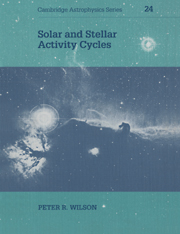Book contents
- Frontmatter
- Contents
- Preface
- Acknowledgments
- 1 Introduction
- 2 Historical survey
- 3 The structure of the Sun and the phenomena of activity
- 4 The equations of magnetohydrodynamics and magnetohydrostatics
- 5 The one-dimensional configuration of the cycle
- 6 Heuristic models of the solar activity cycle
- 7 Stellar activity and activity cycles
- 8 The two-dimensional representation of the extended activity cycle
- 9 The origin of the large-scale fields
- 10 The reversal of the polar magnetic fields
- 11 The role of dynamo theory in cyclic activity
- 12 Helioseismology and the solar cycle
- 13 Cyclic activity and chaos
- 14 Forecasting the solar cycle
- 15 Summary and conclusions
- Author index
- Subject index
6 - Heuristic models of the solar activity cycle
Published online by Cambridge University Press: 27 October 2009
- Frontmatter
- Contents
- Preface
- Acknowledgments
- 1 Introduction
- 2 Historical survey
- 3 The structure of the Sun and the phenomena of activity
- 4 The equations of magnetohydrodynamics and magnetohydrostatics
- 5 The one-dimensional configuration of the cycle
- 6 Heuristic models of the solar activity cycle
- 7 Stellar activity and activity cycles
- 8 The two-dimensional representation of the extended activity cycle
- 9 The origin of the large-scale fields
- 10 The reversal of the polar magnetic fields
- 11 The role of dynamo theory in cyclic activity
- 12 Helioseismology and the solar cycle
- 13 Cyclic activity and chaos
- 14 Forecasting the solar cycle
- 15 Summary and conclusions
- Author index
- Subject index
Summary
round up the usual suspects
CasablancaIntroduction
Although the solar cycle was identified as a sunspot number fluctuation in 1850, and as a magnetic oscillation in 1923, little progress was made in developing theories which might explain the somewhat diverse phenomena associated with it until the latter half of this century. Since 1950, however, several ingenious, and essentially heuristic, models have been proposed, and some have subsequently been supported by more detailed mathematical analyses. Each of these has offered some insight into possible cyclic processes, but none has provided an account consistent with all the available data, or with our current understanding of the physical processes operating within the Sun. Nevertheless, in order to set the stage for later, more mathematical discussions, it may be helpful to review these models briefly in order to see where they have succeeded and to understand how they have failed.
These models may be classified as (i) relaxation models (e.g. Babcock 1961), (ii) forced oscillator models (e.g. Bracewell 1988), or (iii) dynamo wave models (e.g. Parker 1955, Krause and Rädler 1980). Both (i) and (iii) may be regarded as particular examples of the formal mathematical discipline known as dynamo theory, which will be discussed in more detail in Chapter 11. The models to be discussed here have all arisen from attempts to understand the phenomena of the solar cycle and are part of the background against which more recent observational data should be considered.
- Type
- Chapter
- Information
- Solar and Stellar Activity Cycles , pp. 83 - 96Publisher: Cambridge University PressPrint publication year: 1994



